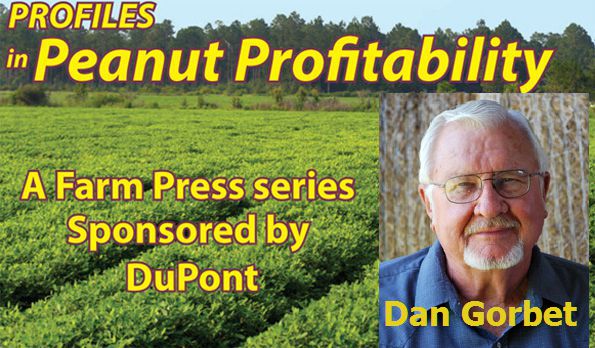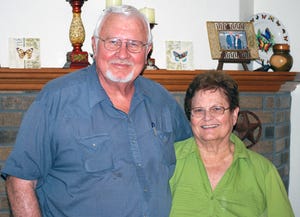
What does being married almost 54 years to the same person have in common with being a top-shelf plant breeder? Both endeavors require a lot of patience combined with some hard-headed persistence and love to get right, says Dan Gorbet.
“When I might act like I’m not be getting my way on something, my wife will remind me everything we’ve pretty much done or have gone to has been to follow my career. … She says it was never her idea to leave Texas in the first place,” said Gorbet as he stood outside his ranch-style home, which sits about two miles down a dirt road flanked by corn fields, pastures and a peanut buying point in Jackson County, Fla.
Gorbet, 72, retired about eight years ago as the University of Florida peanut breeder after near four decades on the job in the same location. Headquartered at, and at times administratively leading, the North Florida Research and Education Center in Marianna, he created the improved disease-resistant peanut varieties that laid the groundwork to the varieties widely used by the industry today. “And the funny thing is it never really was my intention to stay in Florida,” he said.
It was never really his intention to work in peanuts, either. “Peanuts where considered a weed were I’m from,” he said. “Peanuts were considered a weed in our sorghum plots at Oklahoma State University since we followed the peanut research in the plot rotation.”
Gorbet was born and raised in south Texas, Deep South Texas, or around the Corpus Christi area just inland off the Gulf of Mexico. The Gorbets have a long history and attachment to the region. Gorbet’s great-great grandfather Chester Gorbet was an original member of what became known as The Old 300, or the term used for the first settlers Stephen F. Austin brought to colonize southeast Texas between the Brazos and Colorado rivers in the 1820s
Chester came from Pennsylvania to Texas and became a rancher. He fought in and survived the Texas Revolution. He became a Texas Ranger, too, and lived to the ripe old age of 82 (no small miracle for man of his generation and times). He had a few wives, too, because child birth and the harsh elements could be tough at that time, and he ended up with six kids.
As things settled out between the new Texans, the Native Americans and the Mexicans, the Gorbet family flourished in the area. Gorbet’s grandfather, Daniel Ellis Gorbet, who went by his middle name of Ellis, owned and ran a dairy and that provided the young Gorbet with his earliest memories of farm life. Starting with Ellis, there have been four generations of Gorbets with the first name Daniel given to the oldest son.
“We always had some land with a few milk cows and some chickens and stuff like that but my father had a job building the naval air station in Corpus Christi before World War II. He then served in the Army Air Corp during the war in Italy. When he came back from the war, he got a job right back at the base in Corpus Christi,” Gorbet said.
His father retired at 57, moved 70 miles inland to Kenedy, got him a little ranch and lived happily until his death. Gorbet’s mother, Edna, now 92, is still in the area today. Friends and family nearby help her out but she mostly looks after herself just fine.
Oldest peanut breeding program gets new idea
His journey to the academic side of agriculture “just evolved,” he said. “When I started graduate school at Oklahoma State University, (academics) was not my intentions. I was just going to get a master’s degree, come back home and go to work in ag industry, or with a seed company or whatever.”
When his graduate mentor, Dale Weibel, at OSU left on a sabbatical to the Philippines, Gorbet oversaw his sorghum breeding program, working 20 to 30 hours a week with it, plus school work and conducting his own research for his thesis. He felt he had a knack for the work. He also saw older students returning to the university to get doctorate degrees because they felt it was needed to compete in the workforce. He decided he better get his doctorate then and there. By that time, he’d already been married to his high school sweetheart, Mary, for several years. She moved with him and their oldest son, Karl, to Oklahoma. Remember, it was never her idea to leave Texas in the first place, though.

Dan and Mary Gorbet married right out of high school in southeast Texas more than 50 years ago. Though Gorbet became a one of the leading peanut breeders in the country during his career at the University of Florida, Mary sometimes reminds him it was never her idea to leave Texas in the first place.
After completing his doctorate degree at OSU, Gorbet got a job with University of Florida as peanut agronomist located at the UF research center in Marianna. He took it with the stipulation that he could also conduct breeding research along with the agronomy work. Mary, and by then two sons, Karl and Mitchel, moved to Florida with Gorbet.
UF has the oldest peanut breeding programs in the country and goes back to the 1920s. UF agronomist Fred Hull was the first person to artificially hybridize peanuts. In 1943, Dixie Runner was released through the UF program and became widely planted. In the 1969, UF peanut breeder Allen Norden released Florunner. For the next two decades, Florunner dominated the peanut-growing world, especially in the United States, where it accounted for well over two-thirds of the acreage.
But one thing the UF peanut breeding program was not doing much of, or any other breeding program at the time, was developing peanut varieties with disease resistance. Coming from the OSU sorghum breeding program during graduate school, Gorbet knew how important disease-resistance varieties can be for farmers and industry. When he arrived at UF in 1970, Gorbet, with mentorship from Norden, began focusing on producing peanut varieties with disease resistance. Gorbet made more than 100 different cross with new plant introductions between 1972 and 1973.
That forward thinking on breeding peanuts would lay the tracks to save the U.S. peanut industry from the tomato spotted wilt virus in just two short decades.
Remember, it takes patience to be a plant breeder, especially a peanut breeder. “And coming up with a complete peanut package that suits the entire industry is even tougher,” he said.
In 1984, Gorbet and the UF program released Southern Runner, a cross between Florunner and a plant introduction line with leaf spot resistance, and became the first variety with any leaf spot resistance and what later would show some moderate tomato spotted wilt virus resistance: a milestone for peanut breeding.
High-oleic hasn't reached potential, yet
By the early 1990s TSWV had hit Southeast United States and threatened to severely hamper the hub of U.S. peanut production and its future. Georgia Green, released by University of Georgia peanut breeding program, came along with enough TSWV resistance and yield bump to help the industry sustain the TSWV onslaught at the time. One of Georgia Green’s parents was Southern Runner. Most current disease-resistant varieties, including the Georgia-06G variety widely planted now, has C-99R as a parent, released by UF and Gorbet in 1999. C-99R has multiple disease resistance coming from two plant introduction lines in its pedigree.
Building on the work Norden did in the early 1980s, Gorbet introduced SunOleic 95R, the first major variety with high levels of heart-healthy oleic fatty acids, higher even than olive oil, which consumers associate more with the health benefit. But the first high-oleic variety didn’t have TSWV resistance and was not up to the disease’s challenge at the time.
Gorbet went back to developed SunOleic 97R, which had moderate TSWV resistance and higher yield potential than 95R. But high-oleic varieties still did not have adequate TSWV resistance such as Georgia Green or Georgia-06G. The early high-oleic varieties were less economical to grow for farmers. Again, it’s tough to release a peanut package with all the needs of the industry in mind and still be something farmers can plant and make money.
Some colleagues, he says, believe the high-oleic trait may hinder the yield potential of a variety. But Gorbet doesn’t think so. He still believes the high-oleic trait can reach higher and sustainable economic yields for growers. There just has to be the interest in making it happen. Florida 07, a high-oleic variety released by UF and Gorbet, has 7,000 pounds per acre yield potential with TSWV resistance.
“The peanut industry still hasn’t hit its full potential, especially when it comes to promoting the health benefit of high-oleic varieties. Industry wants the longer shelf life, and that’s fine. But if the real proven health benefit of high-oleic peanuts message was ever really gotten through to consumers, we may not be able to grow enough peanuts in the Southeast to meet demand. … But manufactures have to make it worth it for the growers. At one time, premiums were being given to growers to plant high-oleic but that has not been consistent,” he said.
He says competing countries such as Argentina and Australia have well-established high-oleic production that could soon compete for the market. And they are using the SunOleic 97R variety. They call it something else, but it’s the same variety. China and India are also working on high-oleic production. Not there yet, but they are working on it.
It was time for him to get out of the plant-breeding business when he retired in 2006, he said. He needed to spend more time with family and other interest. Besides, the breeding program was in good hands with Dr. Barry Tillman. There was a three-year overlap between Tillman coming on board at UF and Gorbet’s retirement.
Gorbet in a way has gone back to his roots. Down that dirt road in Jackson County, you’ll find his farm where he is “messing with” about 35 mama cows. Cattle prices are really good right now, and that makes it financially worth it. He says it keeps him busy, though his 72-year-old body tells him it might keep him too busy at times.
“I can’t do what I used to,” he said. “And I don’t know for how much longer I can avoid getting hit by cows or other accidents.”
It may never have been Mary’s idea to leave Texas, or Gorbet’s idea to ever work in peanuts. But life takes over the wheel sometimes. He and Mary are settled on their small ranch and this part of north Florida is really home anyway. It has been for a long time.
About the Author(s)
You May Also Like






